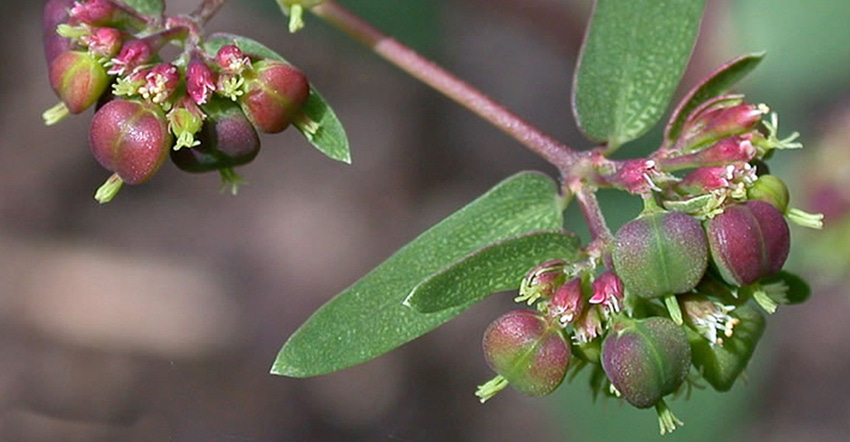
Some weeds are not a problem in pastures. However, there are a few that, if left unchecked, can cause illness and even death to livestock.
University of Missouri Extension weed scientist Kevin Bradley says there are three weeds in Missouri that top his list of most toxic weeds in pastures. He says farmers and ranchers need to scout and treat pastures for perilla mint, poison hemlock and nodding spurge.
1. Perilla mint (Perilla frutescens)
Location: It grows in moist areas along streams or wooded areas.
Identification: Leaves are purple, or green tinged with purple, and appear egg-shaped, with the largest part near the base. Small, white to purplish-white flowers are also present along its branches. This weed can grow to 2 feet in height. All parts of the plant are poisonous.
Injury: Perilla mint causes respiratory distress in all livestock. Symptoms include difficulty exhaling, open-mouth breathing and difficulty moving. Treatment is often ineffective. Missouri has had a number of cattle deaths as a result of ingesting this toxic weed.
Control: 2, 4-D, Grazon P+D, Weedmaster, Remedy or mowing. Warning: Spraying this weed makes it more desirable to cattle. Producers should take precautions to move cattle off sprayed pastures.
2. Poison hemlock (Conium maculatum)
Location: It is found in roadsides and pastures along fencerows, and in no-till corn and soybean fields.
Identification: The growth form of this weed changes during development, which lasts two years. A member of the Apiaceae family — which contains vegetables like carrots — in the first year, the seed leaves tend to look like that of a wild carrot. The seed leaves are smooth and pale green, with deeply lobed leaflets. The first year it will grow to a large rosette of dark glossy-green leaves at least 2 feet long. During the second year, the plant becomes erect, with a thick stem with purple throughout. It can grow to 6 feet if left unchecked. It has an unpleasant odor.
Injury: All livestock and wildlife are susceptible to poison hemlock; however, cattle, horses and goats are most sensitive. The plant attacks the nervous system. Symptoms of poisoning include nervousness, trembling, weak and slow heartbeat and, ultimately, death from respiratory paralysis.
Control: Hand-weeding, mowing and tillage are non-chemical control options for control. Products that contain 2,4-D, dicamba or 2,4-D plus triclopyr are effective as chemical control. Glyphosate also offers some control. However, chemical control is the most effective when applied at the rosette stage. Warning: Temperatures should remain in the 50s (degrees F) when treating pastures for poison hemlock.
3. Nodding spurge (Chamaesyce nutans)
Location: It is found in pastures, cultivated fields and gardens, and on roadsides. It prefers sandy soils.
Identification: Leaves are oblong to oval-oblong, measuring 1/3 to 11/3 inches long. They have rounded tips. Leaf edges are toothed or jagged all around the edge. The flowers are small and white to pink, and appear in clusters. Nodding spurge also bears fruit, roughly 1/10 inch wide and shaded with red. It is a plant that is increasing in southwest Missouri pastures, but has been seen as far north as in the north-central area around Linneus.
Injury: This plant is poisonous fresh or dried. Cases exist of livestock dying after eating in baled hay. The dangerous part of this plant to livestock is the sap, which is poisonous when ingested. Pain and swelling inside the mouth, and blistering and open sores may be present.
Control: Metsulfuron products kill nodding spurge: Cimarron, Cimarron Max, Chaparral, Grazon P +D or GrazonNext. Warning: Spray timing is important. This is a summer annual that appears in the late-summer months of July and August. Make sure you are scouting.
About the Author(s)
You May Also Like






